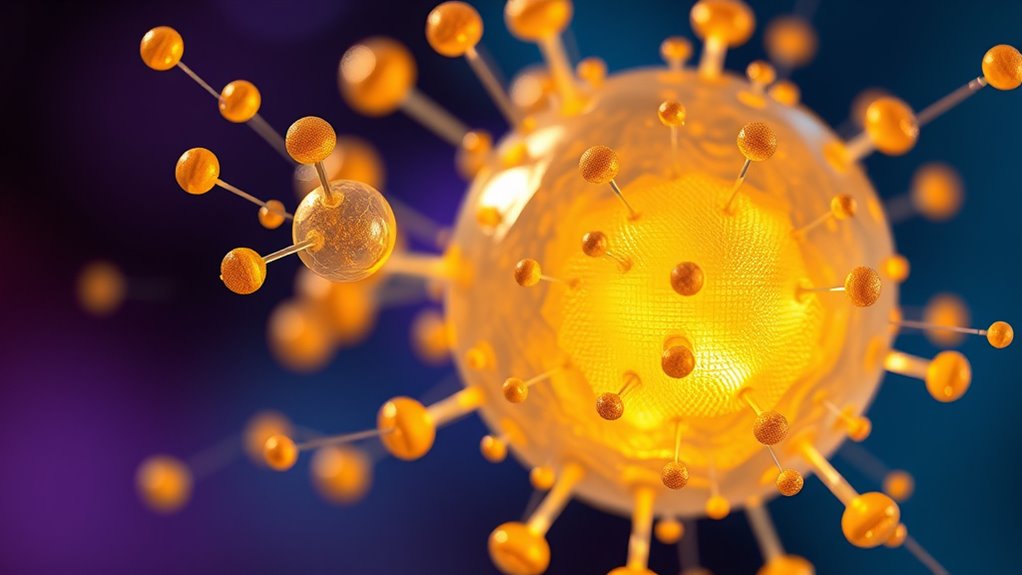Nano-immunotherapy uses nanotechnology to boost your immune system’s ability to fight cancer and infections. It delivers targeted therapies directly to immune cells or tumors, making treatments more precise and effective. Different nanomaterials like liposomes, gold particles, and polymers help activate and modulate immune responses safely. While promising, challenges like toxicity and manufacturing remain. Exploring this innovative approach now will reveal how future treatments might become more personalized and powerful.
Key Takeaways
- Nano-immunotherapy uses nanomaterials to precisely deliver immune-stimulating agents to cancer or infection sites.
- It enhances immune responses by activating T-cells, macrophages, and other immune cells through targeted nanoparticle delivery.
- Nanoparticles improve vaccine efficacy and immune modulation with customizable, biocompatible carriers like liposomes and gold nanomaterials.
- This approach reduces side effects and increases treatment efficiency by focusing therapy on diseased cells.
- Future innovations include personalized vaccines, stimuli-responsive nanocarriers, and targeted immune cell delivery for better outcomes.
The Principles Behind Nano-Immunotherapy

Nano-immunotherapy harnesses nanotechnology to enhance the body’s immune response against cancer. It relies on nanoparticle targeting to deliver therapeutic agents directly to tumor cells or immune cells, increasing precision and reducing side effects. These nanoparticles are designed to recognize specific markers, ensuring they reach the right location. Once there, they activate the immune system more effectively by stimulating immune cells, such as T-cells and macrophages. This targeted approach amplifies immune system activation, helping your body better identify and attack cancer cells. By focusing on efficient delivery and immune stimulation, nano-immunotherapy aims to overcome limitations of traditional treatments and boost your body’s natural defenses against tumors. This principle underpins the innovative strategies driving current research in cancer immunotherapy.
Types of Nanomaterials Used in Immune Enhancement

Different nanomaterials are employed in immune enhancement to improve targeted delivery and stimulate immune responses effectively. Their selection depends on nanomaterial synthesis methods and their ability to target the immune system precisely. You should consider:
Nanomaterials enhance immune targeting and responses, tailored by synthesis methods for optimal immunotherapy outcomes.
- Liposomes – versatile carriers that can encapsulate antigens and adjuvants, enhancing immune system targeting.
- Gold nanoparticles – easy to synthesize, they enable controlled delivery and immune activation.
- Polymer-based nanomaterials – customizable for specific immune targeting and sustained release.
- Carbon-based nanomaterials – like graphene oxide, offering high surface area for functionalization and immune modulation. Additionally, selecting nanomaterials with biocompatibility is crucial to minimize adverse effects and ensure safe immune system engagement.
These nanomaterials are designed to optimize immune response, making them essential in nano-immunotherapy strategies.
Applications of Nano-Immunotherapy in Disease Treatment

Nanomaterials have revolutionized disease treatment by enabling precise and effective immune interventions. Nano-immunotherapy harnesses nanoparticle targeting to deliver drugs directly to diseased cells, boosting immune responses. It also modulates immune checkpoints, enhancing the body’s ability to fight cancer and infections. These advancements offer hope for improved treatments and patient outcomes. Color accuracy and contrast ratio play crucial roles in visualizing treatment effects in research imaging.
Benefits and Challenges of Nanotechnology-Driven Immune Modulation

While nanotechnology offers promising ways to enhance immune modulation, it also introduces a range of benefits and challenges that must be carefully considered. First, nanoparticle targeting improves precision, ensuring the immune system activation occurs exactly where needed. Second, this targeted approach reduces side effects and increases treatment efficiency. Third, nanotechnology can boost vaccine delivery, leading to stronger immune responses. Fourth, however, challenges include potential toxicity, unpredictable interactions with biological systems, and difficulties in large-scale manufacturing. Ensuring safety while maintaining effective nanoparticle targeting remains a key hurdle. Additionally, understanding the security vulnerabilities associated with nanotech-based systems is crucial to prevent potential misuse or data breaches. As you explore nanotech’s role in immune modulation, weigh these advantages against the challenges to fully understand its potential for transformative health solutions.
Future Directions and Innovations in Nano-Immunotherapy

Advancements in nano-immunotherapy are paving the way for more precise and effective treatments, driven by innovations that harness the unique properties of nanotechnology. Future directions include personalized vaccine development, tailoring therapies to individual immune profiles for better outcomes. Additionally, targeted immune cell delivery will improve treatment specificity, reducing side effects and enhancing efficacy. Researchers are exploring multifunctional nanocarriers capable of co-delivering antigens and adjuvants, optimizing immune responses. Innovations like stimuli-responsive nanoparticles will enable controlled release, increasing precision. Collaborative efforts between nanotechnology and immunology will accelerate these advances, making therapies more adaptable. Ultimately, these innovations promise to transform nano-immunotherapy into a more personalized, targeted, and effective approach for fighting diseases. Cultural Intelligence can further facilitate interdisciplinary collaboration and innovation in this rapidly evolving field.
Frequently Asked Questions
How Does Nano-Immunotherapy Compare to Traditional Immunotherapy Methods?
Nano-immunotherapy offers targeted delivery, enabling you to deliver treatments directly to specific immune cells or tumor sites, which improves effectiveness. Unlike traditional methods, it can better modulate your immune response with fewer side effects. This precision allows for enhanced immune modulation, potentially leading to better outcomes. Overall, nano-immunotherapy is more precise and adaptable, giving you a promising alternative to traditional immunotherapy approaches.
Are There Potential Long-Term Side Effects of Nanomaterials in Immune Treatments?
Are you worried about potential toxicity or environmental impact from nanomaterials in immune treatments? Long-term side effects are still being studied, but there’s concern about possible toxicity if nanomaterials accumulate in the body or environment. While nanotech offers promising benefits, you should stay informed about ongoing research to understand their safety profile better. Do you think careful regulation can mitigate these risks effectively?
What Regulatory Hurdles Exist for Clinical Approval of Nano-Immunotherapy Products?
You’ll face regulatory hurdles like establishing clear regulatory pathways and meeting safety standards for nano-immunotherapy products. Agencies demand extensive data on nanomaterials’ safety, efficacy, and potential long-term effects. Managing these requirements can be complex, requiring rigorous clinical trials and detailed documentation. Overcoming these hurdles is essential for gaining approval, ensuring patient safety, and integrating innovative nanotechnology-based immunotherapies into mainstream medicine effectively.
Can Nano-Immunotherapy Be Personalized for Individual Patient Needs?
You can definitely personalize nano-immunotherapy for individual patient needs. Imagine tailoring treatments with patient-specific nanocarriers that target unique tumor markers—this approach boosts effectiveness. Personalization strategies involve customizing nanocarriers based on genetic and immune profiles, ensuring precise delivery. With advancements in nanotechnology, your therapy becomes more targeted, reducing side effects and increasing success rates, making personalized nano-immunotherapy a promising frontier in cancer treatment.
How Cost-Effective Is Nano-Immunotherapy Compared to Existing Treatments?
You’ll find that nano-immunotherapy’s cost analysis shows it’s often more expensive upfront than traditional treatments due to advanced technology and manufacturing costs. However, its potential for higher efficacy and fewer side effects can improve economic feasibility in the long run. While initial investments are higher, the reduced need for additional therapies and hospital stays may offset costs, making it a promising, cost-effective option over time.
Conclusion
By blending brilliance with biology, nano-immunotherapy paves the path for powerful, personalized treatments. As you explore this promising frontier, remember that innovation ignites impact, inspiring improved immunity and incredible outcomes. Embrace the evolving era of nano-knowledge, where tiny tools transform towering health challenges. With continued curiosity and commitment, you’ll help harness nanotechnology’s potential, pushing boundaries and pioneering progress in immune enhancement for a healthier, happier future.









